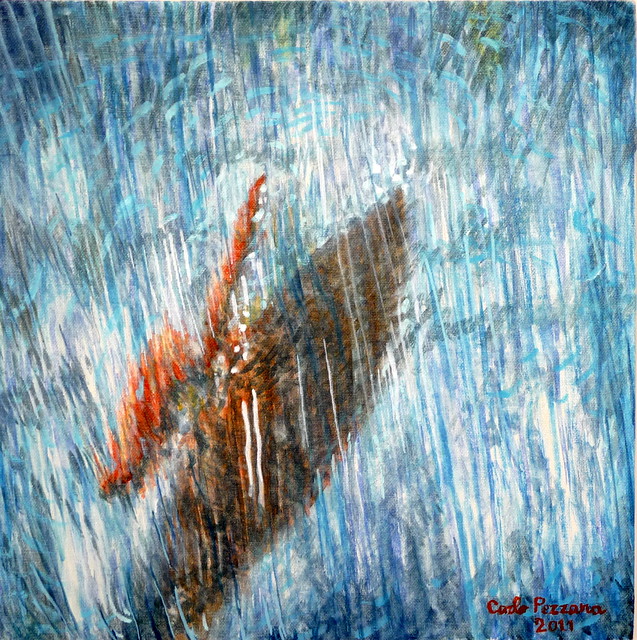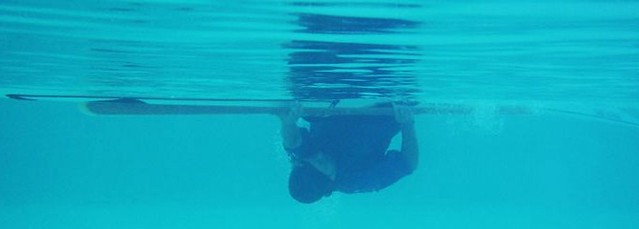.
"Keep on pumping, don't stop, you are doing fine!"
Those were the words of encouragement that I was saying to Tim* hoping he could hear me; he was clearly shaken by the experience.
It was windy and the waves were large enough that he no longer could brace efficiently and eventually he fell in. I was holding his flooded kayak stabilizing him while he was furiously trying to empty it with the hand-held pump. It was working, but just so slowly...
The fear I saw early in Tim's eyes was now slowly subsiding, he knew that he will be alright.
I was on a Sunday outing with a group of kayakers, where the paddling arrangements were loose: we paddle together but without real rules and expectations.
I identified myself with Tim and recalled a few years back when I first joined a kayak club and had my first rescue.
I joined a club to learn the skills necessary to paddle safely in the ocean. I also enjoyed the company of other like-minded paddlers that genuinely loved the sport.
But I am kind of bitter about clubs now; my experience with them leads me to believe that, while they are good in principle, they also attract a fair share of power struggles.
My first exposure to a club was while bushwalking (backpacking).
I was new at the game, very keen but I knew little.
I joined the local club and went on walks and camps with my new-found buddies.
It was fun and I learned a lot. But the longer I was in the club the more I became exposed to the politics that seem inevitable in a structured environment: I observed a good number of people getting very animated about basic issues and some individuals clearly had their heart in the wrong place.
Eventually I no longer wanted to go on their outings as the red tape became too oppressive.
The club was large with several hundred members.
Years later I started sea kayaking.
I knew very little about the sea and I figured that I should really learn how to stay safe out on the water. I was lucky to get involved with a newly formed paddling club that was government sanctioned. For the first year it was really awesome: we all chipped-in with the organizing and there was a real good energy there.
Protocol was simple with not too many rules. Paddling was fun and we really went to great places; the calendar was full of activities.
QSKC trip to Lady Musgrave Island
As the Club grew it attracted individuals that wanted to make a profit from other paddlers while I was not sure if they really loved the sport without the monetary incentive; I call it conflict of interest.
The basic rules were not good enough anymore and a strong push to have mandatory skills to participate on any Club paddles was pushed onto the members. Incidentally those skills could only be "achieved" by being instructed by the few certified commercial operators.
And then it finally dawned on me: this was no longer a bona-fide club, this was becoming a money motivated gig for a few eager individuals.
I was kicked out of the Club for wanting to expose a sexual harassment case and I was bitter about the events. I was also worried that my skills would not advance and I would loose my paddling buddies. I did loose some buddies that, if I look at them now, were rather lame.
Some no longer paddle and some just struggle in the same constrictive environment.
Luckily the Club is not the only way to paddle with others.
Several informal groups are actively involved in sea kayaking where I live.
easy paddle with the Claytons
There are also other Clubs that unfortunately, because of external pressure, seem to be too structured for a real free paddling experience.
I started to paddle more and more frequently with the very same people that shunned the Club that I joined in the first place.
As a novice I used to look at them as a dangerous crowd to paddle with. It seems that the Club culture brain-washed me enough to instill a fear in me to not paddle if not in a totally controlled and anal environment. Initially I felt that we should paddle all together, keeping a constant eye on each other.
Nobody should be no further than a few paddle strokes and if "anything happens" one could be "saved" within seconds. The tall stories of sharks (something that the Club was very good at selling) however had little impact on me as I rationalized the potential danger to a minimum.
the mandatory Club lengthy briefing before launch
So, here I was in the middle of a short passage between islands that had a few bumpy waves tossing us around. A bit of wind was pushing against the tidal flow and I could surf some of the lager waves.
I was having fun but in our group there was a person that probably found the conditions a bit intimidating.
I have kept a loose eye on Tim and while he was doing OK I noticed that he had stiffened up and his paddling stroke was reduced and the catch was a bit short.
At my last wave before the beach I looked back and I no longer could see him, his red kayak and white paddle not around. As the waves were obscuring my view from a low position in the water I spotted him a few minutes later: he was swimming.
I headed back and by the time I reached him he was already getting helped by a passing motor boat. We took it from there: myself and a buddy held Tim's kayak, now with flooded cockpit that was getting emptied by a hand pump. He was a bit shaken, a bit confused and a bit tired. Eventually he started paddling the remaining 1/2 Km back to the beach. I considered offering a tow but I held back: I wanted to offer him instead the possibility to help himself, make him proud of what he achieved.
And then I thought: how would a similar situation be dealt in the Club.
Well, for starters the proposed outing would have been cancelled: too much wind (it was around 15 knots as we set off).
In the event that we would have gone out we would be on top of each other, like a flock of sheep, but not before a lengthy briefing on the beach of all the possible dangers that we could run into, including the shark stories ( I used to get a bit miffed with the scare mongering when I used to be in the Club). Falling in would involve a quick response and the swimmer would be placed back in his kayak within minutes. A good thing, right?
Well, I am not so sure about that...
Let me explain.
I believe in self reliance, in learning from mistakes and by "pulling the finger out".
When I used to fall into the water (and that was often) I was kind of expecting others to come and rescue me, I was relying on them. I had little incentive to actually become a better paddler.
Then I started to paddle by myself and much more aware of my surroundings and my actions: I did become a better paddler. I learned how to roll as swimming was proving to be rather tedious.
I am unsure if I would have advanced as much in the safety of the cocoon called Club.
Considering that today I see on the Club's calendar no real challenging paddles anyway, I would have little opportunity to actually improve myself.
Now, don't get me wrong; clubs are a good thing.
They have introduced me to sports that alternatively would have taken me possibly longer to master.
In a decent club one can learn the basics without having to pay for private tuition, from other more senior members.
Clubs also cater for those that prefer others to make decisions for them. When I led trips in the Club I had my share of participants that really wanted to be guided for the whole paddling event totally foregoing any personal decisions; I understand that we are not all the same and some prefer it that way.
What I really like now instead is to have the freedom to actually paddle where I want. No sign-on sheets, no disclaimers, no herding, no listening to gurus for half an hour before launch in calm conditions. What I prefer is a self reliant group of paddlers that meets and paddles.
We look after each other in a loose way, no holding hands. We teach each other, no money changes hands. And if somebody in the group does not like where we are going he/she is free to do what they want: no sermon before "leaving the pod". A brief acknowledgment that that person will no longer be around for the day is sufficient. There are no formal leaders therefore no liability, we just enjoy each others company with no expectations.
* name has been changed to protect his identity
Showing posts with label skills. Show all posts
Showing posts with label skills. Show all posts
17 December 2014
25 November 2014
VIDEO: sailing with SeaDog 0.7
This time the wind was really blowing and I was glad that I had my smaller sail installed on my kayak: the SeaDog 0.7m².
I could feel that there was less heeling as I didn't have to transfer all my weight to the windy side.
My large sail of 1.0m² would have been too much and harder to handle while my SeaDog 0.7m² was still giving me plenty of speed to surf the waves with ease.
Here is a short video of a few different outings with the SeaDog 0.7m²
I believe that the SeaDog 0.7m² is a great sail for when the wind starts to blow and white caps appear on the water; it offers me plenty of power while still allowing me to handle my more tippy kayaks without a white-knuckled grip on my paddle.
I figured out that a kayak can only go so fast and no matter how big of a sail I mount on the deck it just won't go any faster. A larger sail however just catches more wind and when loaded from the side wind it wants to push the kayak over. I have been at times hanging way over the side of my kayaks trying to keep them from tipping while not noticing any increase in speed over a smaller sail.
Of course, if the wind is from behind (stern wind) and the waves have built up to a size that they start to lift the stern of the kayak where I can surf; my kayak will indeed go faster than hull speed.
It is these times that I find the SeaDog 0.7m² exceptional and easier to handle. As I surf down the wave (on a wind right behind me) the kayak will come to a point where the sail no longer seems to be inflated. At the bottom of the wave I will have the boom flap loose over the deck and wanting to swap sides. Then the gust of wind catches up with me and with a shuddering noise the sail slaps to the other side taken in by the main sheet. It is in this moment that a smaller sail will save me from a sudden imbalance and possible precarious lean that might result in a dunk. I don't feel the raw slap that bigger sails give me in high winds: the 0.7m² is easier to handle.
Another benefit of a smaller sail is when things do go pear shaped and I fall in.
I have been practicing rolling with a sail; starting from dead calm conditions to increased breezes and more bumpy seas. I find that a sail with a smaller surface has much less drag underwater and in a roll I can scull up without too much effort. Recently I have been trying to forego releasing the main sheet and just leave the sail alone while falling in. While slightly more difficult than releasing the main sheet (or uphaul) I am more confident in recovering with the sail just left as it was before falling in.
As winds increase to 20 knots and above I wonder if a smaller sail would not be even better?
Maybe that is something I should look into...
.
I could feel that there was less heeling as I didn't have to transfer all my weight to the windy side.
My large sail of 1.0m² would have been too much and harder to handle while my SeaDog 0.7m² was still giving me plenty of speed to surf the waves with ease.
Here is a short video of a few different outings with the SeaDog 0.7m²
I believe that the SeaDog 0.7m² is a great sail for when the wind starts to blow and white caps appear on the water; it offers me plenty of power while still allowing me to handle my more tippy kayaks without a white-knuckled grip on my paddle.
I figured out that a kayak can only go so fast and no matter how big of a sail I mount on the deck it just won't go any faster. A larger sail however just catches more wind and when loaded from the side wind it wants to push the kayak over. I have been at times hanging way over the side of my kayaks trying to keep them from tipping while not noticing any increase in speed over a smaller sail.
Of course, if the wind is from behind (stern wind) and the waves have built up to a size that they start to lift the stern of the kayak where I can surf; my kayak will indeed go faster than hull speed.
It is these times that I find the SeaDog 0.7m² exceptional and easier to handle. As I surf down the wave (on a wind right behind me) the kayak will come to a point where the sail no longer seems to be inflated. At the bottom of the wave I will have the boom flap loose over the deck and wanting to swap sides. Then the gust of wind catches up with me and with a shuddering noise the sail slaps to the other side taken in by the main sheet. It is in this moment that a smaller sail will save me from a sudden imbalance and possible precarious lean that might result in a dunk. I don't feel the raw slap that bigger sails give me in high winds: the 0.7m² is easier to handle.
Another benefit of a smaller sail is when things do go pear shaped and I fall in.
I have been practicing rolling with a sail; starting from dead calm conditions to increased breezes and more bumpy seas. I find that a sail with a smaller surface has much less drag underwater and in a roll I can scull up without too much effort. Recently I have been trying to forego releasing the main sheet and just leave the sail alone while falling in. While slightly more difficult than releasing the main sheet (or uphaul) I am more confident in recovering with the sail just left as it was before falling in.
As winds increase to 20 knots and above I wonder if a smaller sail would not be even better?
Maybe that is something I should look into...
.
11 November 2014
Video: Radikal Kayak Surfing
I love this video.
Beside the incredibly smooth kayak surfing demonstrating outstanding skills using an unconventional paddle, the footage capture and the editing is really captivating.
It inspires me to get out more in the rough stuff and play.
My aspirations: to be one day half as good as Marc.
.
Beside the incredibly smooth kayak surfing demonstrating outstanding skills using an unconventional paddle, the footage capture and the editing is really captivating.
It inspires me to get out more in the rough stuff and play.
My aspirations: to be one day half as good as Marc.
.
17 March 2014
Photo: foam pile
.
Playing in messy conditions with waves coming from different directions is one of the best training grounds for improving my skills.

I was joined by Peter who has only recently learned how to roll.
It was so rewarding to see his improved skills that allowed him to go for the biggest waves, now that he can confidently come back up when tossed over by a wave.
We both had a ball.
.
Playing in messy conditions with waves coming from different directions is one of the best training grounds for improving my skills.

I was joined by Peter who has only recently learned how to roll.
It was so rewarding to see his improved skills that allowed him to go for the biggest waves, now that he can confidently come back up when tossed over by a wave.
We both had a ball.
.
02 December 2013
Why a tippy kayak can be a good thing
.
A few months ago I paddled a new kayak that really impressed me: the XP designed by Johan Wirsen.
He lent me his personal kayak for a 500 km trip along the Swedish East coast. I had never paddled that kayak and I knew it was going to be very different to my British kayaks.
Along the way I really had a chance to test the kayak properly and I fell in love with it. The kayak was loaded with supplies and camping gear and it sat relatively stable in the water; I never had the chance to paddle it unloaded. I really wanted that kayak because it fitted me so well and allowed me to sit with my legs together, not splayed wide to fit under the thigh braces. It paddled with ease and responded very well to edging.
Once back in Australia I was lucky to get hold of a rare ultralight version; the XP is no longer in production because of copyright breach on the part of the manufacturer.
When I finally got to paddle the XP in my local waters I suddenly realized that this was a very different kayak. While the mould and shape were identical to what I had in Sweden I felt that my kayak was now so incredibly twitchy.

With its rather deep V hull shape and a narrow beam the unloaded kayak sat very differently on the water.
My first paddle in choppy conditions found me not in the usual relaxed style but I was bracing every so often to avoid falling in. I was concerned that this kayak might get relegated to “calm” days only but I really wanted to use it in all conditions. I took her out on challenging weather and despite feeling uncomfortable and needing to brace often I persisted.
Slowly my body got used to the tippiness and while I am not totally relaxed in her yet I can come back from a paddle no longer white knuckled.
I remember buying a few years ago another kayak (no test paddle) that I was disappointed with: I kept falling in. I was ready to on sell it but somehow persisted and developed the skill to paddle that demanding kayak. It later became my favorite surfing kayak, unfortunately the cockpit does not fit me that well.
As some say there is no such thing as a tippy kayak, just tippy paddlers I find that it takes a bit of time to overcome the initial low initial stability of a narrow hull. What I gain from my new kayak is increased skills and performance on small waves: I can easily surf wind waves that I can not in my British kayaks. While not perfectly suited to all the conditions that Moreton Bay offers (it’s a handful in short steep tidal flow driven waves) I find the performance superior to other kayaks I have.
Jeff Allen in Ocean Paddler magazine writes:
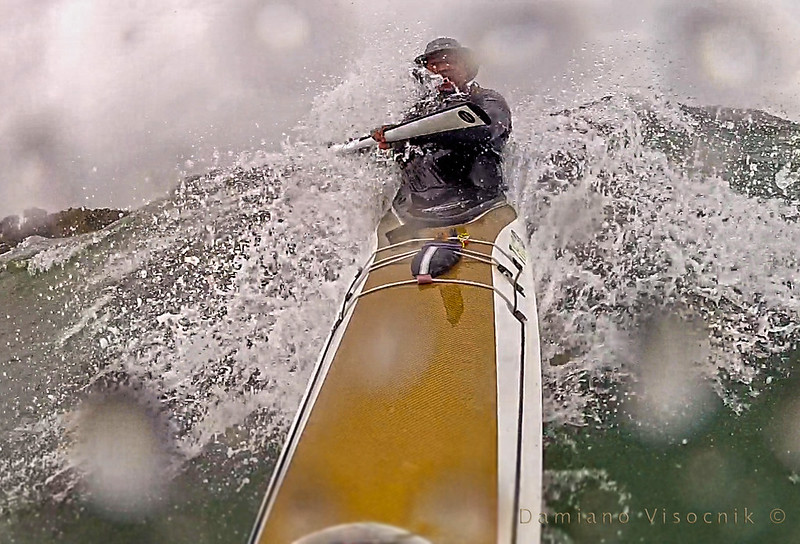
In my previous life I used to ride passionately mountain bikes. My regular riding partner has a similar trail bike to mine. She was usually lagging behind a bit and I had to wait for her on some rides. She then decided to try riding a single speed on hilly trails. I thought she was mad to forego gears and make her riding harder; she sure will be a real drag…
And she was, for a few weeks. Then her technique improved, her riding style changed and her strength increased as she no longer wanted to get off on the hills she could not ride with the single speed. In a month’s time she was on my wheel and soon after she started to leave me behind.
I realized that by making her conditions harder she became a better rider since she wanted to ride that bike and not walk it, while myself I never pushed hard enough riding my geared bike: I could simply downshift on harder terrain. I never had the courage to go singlespeed but I wished I did; I would have ridden those Californian trails with more finesse and strength.
.
A few months ago I paddled a new kayak that really impressed me: the XP designed by Johan Wirsen.
He lent me his personal kayak for a 500 km trip along the Swedish East coast. I had never paddled that kayak and I knew it was going to be very different to my British kayaks.
Along the way I really had a chance to test the kayak properly and I fell in love with it. The kayak was loaded with supplies and camping gear and it sat relatively stable in the water; I never had the chance to paddle it unloaded. I really wanted that kayak because it fitted me so well and allowed me to sit with my legs together, not splayed wide to fit under the thigh braces. It paddled with ease and responded very well to edging.
Once back in Australia I was lucky to get hold of a rare ultralight version; the XP is no longer in production because of copyright breach on the part of the manufacturer.
When I finally got to paddle the XP in my local waters I suddenly realized that this was a very different kayak. While the mould and shape were identical to what I had in Sweden I felt that my kayak was now so incredibly twitchy.

With its rather deep V hull shape and a narrow beam the unloaded kayak sat very differently on the water.
My first paddle in choppy conditions found me not in the usual relaxed style but I was bracing every so often to avoid falling in. I was concerned that this kayak might get relegated to “calm” days only but I really wanted to use it in all conditions. I took her out on challenging weather and despite feeling uncomfortable and needing to brace often I persisted.
Slowly my body got used to the tippiness and while I am not totally relaxed in her yet I can come back from a paddle no longer white knuckled.
I remember buying a few years ago another kayak (no test paddle) that I was disappointed with: I kept falling in. I was ready to on sell it but somehow persisted and developed the skill to paddle that demanding kayak. It later became my favorite surfing kayak, unfortunately the cockpit does not fit me that well.
As some say there is no such thing as a tippy kayak, just tippy paddlers I find that it takes a bit of time to overcome the initial low initial stability of a narrow hull. What I gain from my new kayak is increased skills and performance on small waves: I can easily surf wind waves that I can not in my British kayaks. While not perfectly suited to all the conditions that Moreton Bay offers (it’s a handful in short steep tidal flow driven waves) I find the performance superior to other kayaks I have.
Jeff Allen in Ocean Paddler magazine writes:
The other point about stable sea kayaks is that, if we take a beginner and put them straight into
a stable design, we gain instant success; they don’t need to learn a high degree of balance or effective bracing, they get away without the need to develop those most fundamental of skills. They develop the strokes in a stable craft /environment, but, when they move onto a more dynamic environment and try a simple sweep stroke in bubbly water, we see them capsize.
A lack of balance and supporting blade angle are usually the culprit, which would have been their
first lesson had they started the process in a less-than-stable sea kayak. That is quite a radical
thought however, and (I hasten to add) is only my opinion. Much of our industry is based around
maintaining a good client base; happy customers will keep coming back for more.

In my previous life I used to ride passionately mountain bikes. My regular riding partner has a similar trail bike to mine. She was usually lagging behind a bit and I had to wait for her on some rides. She then decided to try riding a single speed on hilly trails. I thought she was mad to forego gears and make her riding harder; she sure will be a real drag…
And she was, for a few weeks. Then her technique improved, her riding style changed and her strength increased as she no longer wanted to get off on the hills she could not ride with the single speed. In a month’s time she was on my wheel and soon after she started to leave me behind.
I realized that by making her conditions harder she became a better rider since she wanted to ride that bike and not walk it, while myself I never pushed hard enough riding my geared bike: I could simply downshift on harder terrain. I never had the courage to go singlespeed but I wished I did; I would have ridden those Californian trails with more finesse and strength.
.
16 November 2013
Video: Neptun Kajakk
Every so often I come across a kayaking video that leaves me speechless.
And this is one of them:
Norway - Jæren from Roald Holm on Vimeo.
Worth watching in High Definition and full screen, not on a mobile device..
.
And this is one of them:
Norway - Jæren from Roald Holm on Vimeo.
Worth watching in High Definition and full screen, not on a mobile device..
.
04 April 2013
Nigel Foster's finesse
Nigel Foster's presentation of his Arctic trip by sea kayak was awe inspiring.

There was a breeze stiff enough to deter some paddlers from launching and wind driven waves were lashing the sandy shore.

The seas were calmer than the previous day but the swell outside the bay was still a considerable 10 feet with a healthy rebound from the big waves crashing into the cliffs.
I gained new respect for the man that took on almost uncharted waters (by kayak standards) in very inhospitable conditions; cold and windy and patrolled by polar bears.
My first knowledge of this exceptional kayaker was years ago watching his instructional DVDs.
I was mesmerized by the incredible finesse he was using to make that kayak spin around like it was on a bearing.
I was however a bit incredulous on how easily his kayak could dance with so little effort. No paddle sweeps, no excessive edging, just confident paddle placement that to my ignorant eye seemed fit only for calm conditions.
I was now watching him from my kayak, on the water.

There was a breeze stiff enough to deter some paddlers from launching and wind driven waves were lashing the sandy shore.
I was back-paddling constantly just to keep position to watch him.
And with just as much finesse as in his DVD he was spinning that kayak around in circles like the water was flat and nary a whiff of wind.
No huffing and no puffing, with paddle strokes slowly paced and precisely placed his kayak was dancing on the water regardless of the adverse conditions.
The man is a Master like I have not seen before.

Despite his status of true authority on the water, a paddler with no equal, Nigel is extremely approachable and willing to share his knowledge without the air of superiority that I have encountered elsewhere. Softly spoken, thoughtful and considered, my conversation with Nigel was easy and inspiring.
As the 3 day sea kayak event (Rock and Roll) was drawing to an end Nigel had the morning free to go for fun paddle, not scheduled to any instructions.
I was lucky to join him with Andre Janecki of Hybrid Australia.
I paddled beside Nigel and if I didn’t see him launch his kayak I would have sworn that there was a little motor under his hull. He was paddling with a cadence that seemed like lily dipping while I was giving it my best shot to keep up. I watched him closely and his timing was crucial to his paddle stokes. I later asking how he could move with such grace and so little apparent effort; he replied that he was using the little waves to propel his kayak.
His stroke appeared to be lower than the current local trend of a high angle and aggressive body rotation. I saw gentle twist of his upper torso and his hand rather low, gently inserting his paddle to then exit a bit further than “Olympic form” would suggest.
I regard Nigel Foster without a doubt a "Legend" and a "Master of boat control without equal". 27 November 2012
VIDEO: too windy
I believe in pushing myself in environments that are often outside my comfort level.
It is in conditions that test my skills and endurance that I gain a better understanding of my potential and abilities. I encourage others to do so too because I see it as the only thing that really improves a person's confidence, fast.
Lately I have been spending more and more time paddling in windy conditions because I feel that I greatly need to gain more skills in developed seas.
I used to dread a windy forecast; anything above 15 knots would make me reconsider my paddling plans. Now I look for winds that will oppose a tidal flow hoping for some waves that will mimic a tidal race. Bumpy is good.
Saturday's forecast was mild (up to 15 knots) but Sunday was shaping to have 25-35 knots wind against an ebbing tidal flow. I have paddled a few times there before and I knew that with onshore winds waves will form.
What I didn't know is that too much wind doesn't make for better fun.
I reefed my Code Zero Flat Earth sail to reduce it's surface knowing that a full square meter was going to be too much for me to handle.
Soon after I launched I was again glad to be paddling with a Greenland paddle remembering how much more wind effected my Euro paddles used to be in a stiff breeze.
My progress was a bit erratic and the strong wind kept on pushing my bow downwind. The British kayak I was paddling has proven a handful before I relocated the seat forward (to balance its trim for beam winds); this time her handling was really lousy. I wished I would have weighted the bow with ballast to release the stern a bit as I could barely turn my kayak around and paddle back out into the waves for another run.
Getting the kayak back from the shore across the sandblasting beach with me leaning at a great angle into the wind, was another story.
.
It is in conditions that test my skills and endurance that I gain a better understanding of my potential and abilities. I encourage others to do so too because I see it as the only thing that really improves a person's confidence, fast.
Lately I have been spending more and more time paddling in windy conditions because I feel that I greatly need to gain more skills in developed seas.
I used to dread a windy forecast; anything above 15 knots would make me reconsider my paddling plans. Now I look for winds that will oppose a tidal flow hoping for some waves that will mimic a tidal race. Bumpy is good.
Saturday's forecast was mild (up to 15 knots) but Sunday was shaping to have 25-35 knots wind against an ebbing tidal flow. I have paddled a few times there before and I knew that with onshore winds waves will form.
What I didn't know is that too much wind doesn't make for better fun.
I reefed my Code Zero Flat Earth sail to reduce it's surface knowing that a full square meter was going to be too much for me to handle.
Soon after I launched I was again glad to be paddling with a Greenland paddle remembering how much more wind effected my Euro paddles used to be in a stiff breeze.
My progress was a bit erratic and the strong wind kept on pushing my bow downwind. The British kayak I was paddling has proven a handful before I relocated the seat forward (to balance its trim for beam winds); this time her handling was really lousy. I wished I would have weighted the bow with ballast to release the stern a bit as I could barely turn my kayak around and paddle back out into the waves for another run.
I will take a weathercocking kayak over a "neutral" one any day. In a weathercocking one I can drop a bit of skeg; in a so called neutral, when the wind really blows, it suddenly becomes lee cocking, something I definitely DO NOT want.
My attempt at sailing was dismal: even with only half sail I could not get my kayak going and I quickly capsized. It was then that all the futzing with sculling training in clam conditions came handy as I managed to roll back up without having to wet exit in a rather tricky scenario. I packed the sail back on the deck and continued to just surf the messy waves.
After a few hours of battling with the wind I called it a day.Getting the kayak back from the shore across the sandblasting beach with me leaning at a great angle into the wind, was another story.
.
17 July 2012
VIDEO: Zipper Zone Futzing
.
I like it bumpy, always have.
From bicycles pedalled on rocky terrain, motorcycles ridden off road to bushwalking cross country I recognize a passion for the challenging conditions.
Mindless rhythmical power exertion of my body does not interest me and I usually seek locations where skills and balance are more important than muscles. The same goes for sea kayaking: I seek waters that offer a bit of excitement and unpredictability, where I have to use my body and bracing to keep myself upright.
select HD if you have fast Internet connection
My local paddling location is a sheltered bay away from ocean swell and lacking a rocky coastline I don’t have anywhere to practice my balancing skills in clapotis rebound. Moreton Bay however has a decent tidal flow with 6-7 feet of height variation at spring tides creating shifting banks of sand a few miles from the shore. Power boaters avoid the area and take a different route to travel to the big sandy Moreton Island. I instead seek those locations where tidal flow, residual ocean swell and small wind waves, from the opposite direction, meet over shallow waters of sand banks. The opposing forces of the two waves collide and at the right moment peak high with a great splash. With the confidence offered by the Northern Light Greenland paddle, I play in the area hoping to get caught in the very spot of collision to get tossed high in the air.
.
I like it bumpy, always have.
From bicycles pedalled on rocky terrain, motorcycles ridden off road to bushwalking cross country I recognize a passion for the challenging conditions.
Mindless rhythmical power exertion of my body does not interest me and I usually seek locations where skills and balance are more important than muscles. The same goes for sea kayaking: I seek waters that offer a bit of excitement and unpredictability, where I have to use my body and bracing to keep myself upright.
select HD if you have fast Internet connection
My local paddling location is a sheltered bay away from ocean swell and lacking a rocky coastline I don’t have anywhere to practice my balancing skills in clapotis rebound. Moreton Bay however has a decent tidal flow with 6-7 feet of height variation at spring tides creating shifting banks of sand a few miles from the shore. Power boaters avoid the area and take a different route to travel to the big sandy Moreton Island. I instead seek those locations where tidal flow, residual ocean swell and small wind waves, from the opposite direction, meet over shallow waters of sand banks. The opposing forces of the two waves collide and at the right moment peak high with a great splash. With the confidence offered by the Northern Light Greenland paddle, I play in the area hoping to get caught in the very spot of collision to get tossed high in the air.
.
26 June 2012
TECHNIQUE: Greenland paddles used in all conditions
.
The popularity of Greenland paddles has been growing rapidly. I no longer feel like being the "ugly duckling" when I meet other paddlers on the water and while there is still some disdain in certain circles the majority of the paddlers are accepting GPs as an alternative style to the high angle big blade Euro paddling.
But like all things that are different and don't conform to the status quo, they attract resistance by the old school masters. Ironically Greenland paddles are one of the oldest forms of paddles, it's just that modern materials have allowed for advancements in paddle design that led to short and wide blades that then became the norm and the old form was nearly forgotten (even tho short and wide was not unknown, just not as popular as in modern times).
The renessaince of the Greenland paddle would seem to be driven by nostalgia and would appeal to sea kayakers that work with timber and like to make their own equipment.
And that is true for the vast majority of the Greenland paddlers.
As Greenland paddles excel for rolling and plenty of paddlers practice the art of rolling with GPs, they are often also associated with paddling in calm conditions where an easy steady pace to cover distance is often sufficient and matches the speed of Euro paddling.
But things change when we talk about dynamic waters.
A lot of paddlers shake their heads when I suggest that the GP is a very useful and powerful paddle in the textured waters. Surely there is a difference between the skinny stick and the fat blade, is their argument.
Yes, there is an undeniable difference between the "big water" short blade of white water inspired sea kayak paddle and the distributed surface of a GP.
I would like to emphasize the "distributed"
A lot of Greenland paddles have a surface area that is similar to touring Euro paddles. Yep, if one measures the whole blade of the GP the numbers add up. If the GP is on the long side (230cm+)the surface area is actually surprising large and can exceed the widest Euro paddles, however I find no need to have an extra wide or long GP for playing in dynamic waters. A typical cruising GP stroke is a low angle one where often just a portion of the blade is inserted into the water.
That is actually all is needed to cruise in a sea kayak: very little effort in propelling that hull in the water.
If one wants to then push the kayak and get close to hull speed more energy is required. While the common conception is that one has to paddle "faster" (higher cadence) to go faster with a GP I tend to change the angle of insertion of the blade into the water.
Once my stroke angle becomes higher I can deliver more blade into the water (more surface) and I have more resistance (less "slipping" back of the paddle) to apply more energy to my stroke. I can travel just as fast with a GP than with a EP.
So how does that translate to dynamic water paddling?
James Manke using a Greenland paddle (Northern Light) in all comditions
I use a higher angle when paddling in the surf zone, where I want a faster acceleration with my kayak; more blade enters the water allowing me to have more grunt.
Of course, water being a fluid substance, will flow around the skinny GP easier than a fat EP and while the difference is noticeable is not impossible to overcome. It is at this moment that I apply a higher cadence to achieve the desired initial propulsion in my kayak.
I think of it as driving a smaller engine car that is delivering the desired power by revving higher than a big block V8; the feel is different but the results similar.
So, in the surf zone where acceleration is really needed I have a higher angle and a higher cadence.
It is a short burst that is needed to get me gliding along with the energy of the wave.
The biggest benefit I find in a GP is the gentle support that it offers in a high brace.
As I surf along the wave I often broach, where my kayak is suddenly in line with the wave and getting pushed along sideways. If I don't want to get tipped I use a high brace to stabilize myself, like an outrigger.
As the waves can be occasionally powerful when I broach, the paddle in a high brace position tends to get elevated to the surface of the water. I feel that with a Greenland paddle that force is never as strong as with a wide bladed EP where a high position of my elbow could risk getting me a dislocated shoulder.
I seem to be able to contain that force and try to keep my arm in a much safer location.
Few can demonstrate the validity of the of the GP as an all rounder paddle better than Warren Williamson can in this video of extremely fast and turbulent waters of Deception Pass in WA, USA.
And while the current record of paddling around Vancouver Island is held by Joe O'Blenis with a Greenland paddle, we even have the Brits joining in the retro revolution with paddling around their big island .
.
The popularity of Greenland paddles has been growing rapidly. I no longer feel like being the "ugly duckling" when I meet other paddlers on the water and while there is still some disdain in certain circles the majority of the paddlers are accepting GPs as an alternative style to the high angle big blade Euro paddling.
But like all things that are different and don't conform to the status quo, they attract resistance by the old school masters. Ironically Greenland paddles are one of the oldest forms of paddles, it's just that modern materials have allowed for advancements in paddle design that led to short and wide blades that then became the norm and the old form was nearly forgotten (even tho short and wide was not unknown, just not as popular as in modern times).
The renessaince of the Greenland paddle would seem to be driven by nostalgia and would appeal to sea kayakers that work with timber and like to make their own equipment.
And that is true for the vast majority of the Greenland paddlers.
As Greenland paddles excel for rolling and plenty of paddlers practice the art of rolling with GPs, they are often also associated with paddling in calm conditions where an easy steady pace to cover distance is often sufficient and matches the speed of Euro paddling.
But things change when we talk about dynamic waters.
A lot of paddlers shake their heads when I suggest that the GP is a very useful and powerful paddle in the textured waters. Surely there is a difference between the skinny stick and the fat blade, is their argument.
Yes, there is an undeniable difference between the "big water" short blade of white water inspired sea kayak paddle and the distributed surface of a GP.
I would like to emphasize the "distributed"
A lot of Greenland paddles have a surface area that is similar to touring Euro paddles. Yep, if one measures the whole blade of the GP the numbers add up. If the GP is on the long side (230cm+)the surface area is actually surprising large and can exceed the widest Euro paddles, however I find no need to have an extra wide or long GP for playing in dynamic waters. A typical cruising GP stroke is a low angle one where often just a portion of the blade is inserted into the water.
That is actually all is needed to cruise in a sea kayak: very little effort in propelling that hull in the water.
If one wants to then push the kayak and get close to hull speed more energy is required. While the common conception is that one has to paddle "faster" (higher cadence) to go faster with a GP I tend to change the angle of insertion of the blade into the water.
Once my stroke angle becomes higher I can deliver more blade into the water (more surface) and I have more resistance (less "slipping" back of the paddle) to apply more energy to my stroke. I can travel just as fast with a GP than with a EP.
So how does that translate to dynamic water paddling?
James Manke using a Greenland paddle (Northern Light) in all comditions
I use a higher angle when paddling in the surf zone, where I want a faster acceleration with my kayak; more blade enters the water allowing me to have more grunt.
Of course, water being a fluid substance, will flow around the skinny GP easier than a fat EP and while the difference is noticeable is not impossible to overcome. It is at this moment that I apply a higher cadence to achieve the desired initial propulsion in my kayak.
I think of it as driving a smaller engine car that is delivering the desired power by revving higher than a big block V8; the feel is different but the results similar.
So, in the surf zone where acceleration is really needed I have a higher angle and a higher cadence.
It is a short burst that is needed to get me gliding along with the energy of the wave.
The biggest benefit I find in a GP is the gentle support that it offers in a high brace.
As I surf along the wave I often broach, where my kayak is suddenly in line with the wave and getting pushed along sideways. If I don't want to get tipped I use a high brace to stabilize myself, like an outrigger.
As the waves can be occasionally powerful when I broach, the paddle in a high brace position tends to get elevated to the surface of the water. I feel that with a Greenland paddle that force is never as strong as with a wide bladed EP where a high position of my elbow could risk getting me a dislocated shoulder.
I seem to be able to contain that force and try to keep my arm in a much safer location.
Few can demonstrate the validity of the of the GP as an all rounder paddle better than Warren Williamson can in this video of extremely fast and turbulent waters of Deception Pass in WA, USA.
And while the current record of paddling around Vancouver Island is held by Joe O'Blenis with a Greenland paddle, we even have the Brits joining in the retro revolution with paddling around their big island .
.
17 April 2012
Inspired by GnarlyDog News?
A recent YouTube video has been brought to my attention where a paddler performs a similar balancing act to my recent guest Geggamoja video .
In "Sea Kayak Video Production" video a happy paddler with remarkable balance tries to stand on the deck of his kayak.
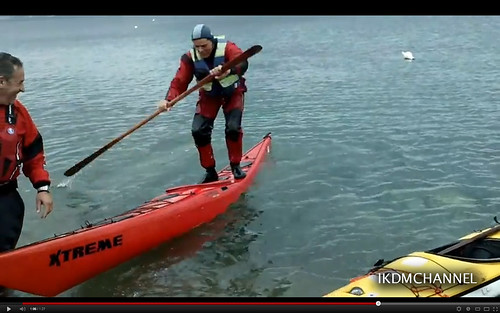
YouTube screen-shot
I then read his accompanying description on the video where he says:
>>It usually takes several years dedicated to paddle before being
able to balance standing in a kayak.
Some of us, probably, they will never (like me),
others do not see any purpose,
just like some people do not see any reason to learn how to roll a kayak.
I admire these kayakers able to handle the kayak with ways so
graceful .....
able to communicate with a few simple steps ...
real Guru can teach all of us ...
<<
Wait a minute... those words sound familiar!
In my post I write:
It usually takes a few years of dedicated paddling to be able to balance standing in a narrow beam kayak. Some of us will probably never get it (like myself) and some will see no point in it.
Just like some see no reason for learning how to roll a kayak or master more than a sketchy combat roll, I admire paddlers that can finesse the boat with graceful strokes.
Have I inspired people across the pond, all the way to Italy, to mimic Geggamoja video and copy my text?
Should I think that imitation is the sincerest form of flattery?
If nothing else, at least it has inspired people to have a go and make it fun :-)
.
In "Sea Kayak Video Production" video a happy paddler with remarkable balance tries to stand on the deck of his kayak.

YouTube screen-shot
I then read his accompanying description on the video where he says:
>>It usually takes several years dedicated to paddle before being
able to balance standing in a kayak.
Some of us, probably, they will never (like me),
others do not see any purpose,
just like some people do not see any reason to learn how to roll a kayak.
I admire these kayakers able to handle the kayak with ways so
graceful .....
able to communicate with a few simple steps ...
real Guru can teach all of us ...
<<
Wait a minute... those words sound familiar!
In my post I write:
It usually takes a few years of dedicated paddling to be able to balance standing in a narrow beam kayak. Some of us will probably never get it (like myself) and some will see no point in it.
Just like some see no reason for learning how to roll a kayak or master more than a sketchy combat roll, I admire paddlers that can finesse the boat with graceful strokes.
Have I inspired people across the pond, all the way to Italy, to mimic Geggamoja video and copy my text?
Should I think that imitation is the sincerest form of flattery?
If nothing else, at least it has inspired people to have a go and make it fun :-)
.
tags
balance,
blog,
copyright infringment,
fun,
playboating,
publishing,
readers,
sea kayak,
skills
03 April 2012
VIDEO: backsurfing with a stick
I am gaining confidence with my Northern Light Greenland paddle and slowly I have improved my maneuverability in small surf. From the small shore break I have progressed to something just a bit more challenging.
select 720p if you have fast Internet connection
I still have not had the opportunity (and the courage) to tackle large waves and I am working on edging my kayak when the world slides backwards.
In the meantime I am learning how to control my kayaks when surfed in reverse and avoid being broached too soon.
The thrill of not seeing where I am going and the fear of getting pitched stern deep into the water compensates for my lame technique. This play-boating teaches me timing and body-weight shift to maximize the free ride.
Would a rudder help me?
.
select 720p if you have fast Internet connection
I still have not had the opportunity (and the courage) to tackle large waves and I am working on edging my kayak when the world slides backwards.
In the meantime I am learning how to control my kayaks when surfed in reverse and avoid being broached too soon.
The thrill of not seeing where I am going and the fear of getting pitched stern deep into the water compensates for my lame technique. This play-boating teaches me timing and body-weight shift to maximize the free ride.
Would a rudder help me?
.
27 March 2012
Profile: Jill Remme_outdoor photographer
.
I stumbled across Jill's work when she became a follower of GnarlyDog News.
Her profile linked me to her blog site (jillremme.blogspot.com) and I was immediately taken by her images.

I have checked her blog on a regular basis for a while and every time I was really impressed with her work.
Jill possesses an incredible talent that allows her to view the world through the lens of a camera like very few other photographers can: to me, her images convey passion, happiness and love.
I finally approached Jill and asked her a few questions; I wanted to know how she developed that photographic view.
("amber" is GD, "light blue" is Jill)
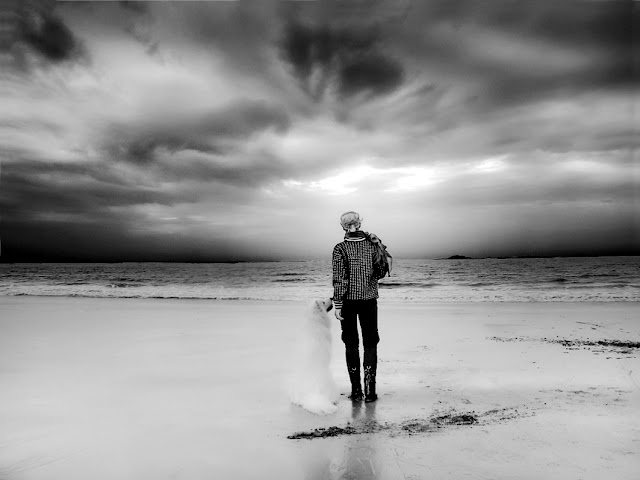
1) Jill, you photographic work is outstanding. So, how long have you been photographing and what sparked the passion?
I guess all my beautiful tours in nature spark the passion further and further. The love for nature and the movement in a picture to capture the moment….I love coming home and see what is the catch of the day on my camera; it is one of my favorite thing to do. I had my first camera when I was 17, and I still have that old Canon. I think I spent a small fortune to capture images before digital came along.
2) Your work has a very friendly and lovable feeling. Your portraits depict very relaxed faces and the subjects are really pretty. Are they professional models or just friends?

It is mostly friends and family. I really enjoy taking pictures of my children. I have three daughters and one son, two of them are stepchildren :) It's always fun to be with them; so that's perhaps why they look so relaxed. And now I also have a grandchild; lucky me!
Occasionally people ask me if I can take their pictures, but I more often say no than yes :)
3) Do you spend some time planning the photographs that you are going to take or is it just candid capturing of moments as they happen in front of the camera? With the portraits, do you have any special technique to put your models at ease or are you just good friends and they feel relaxed?
I have no other technique than: I try to think of the light and movement: I try to catch people as they are in that moment, but it is not always so easy. I rarely or never plan. I get inspired by others and the pictures I see on the Internet and other places. What inspires me most is just being in nature and enjoying it. I also use Photoshop when images aren't captured they way I saw them.
I spend some time trying to think up new ideas and angles but I often feel that I repeat myself. Sometimes I succeed, sometimes not.
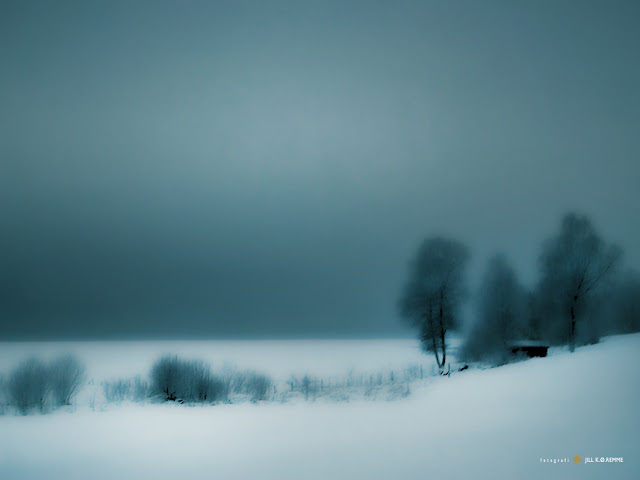
4) Your images are taken often in very cold places and you seem to love the outdoors a lot. Do you prepare or protect your digital cameras in any special way to make the battery last?
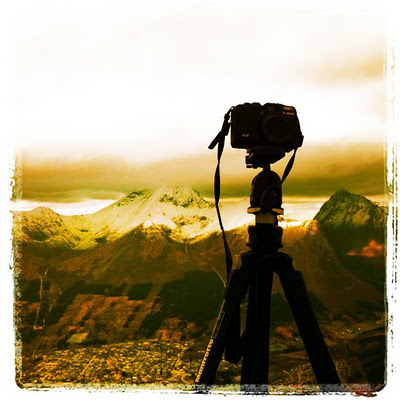
My camera is well tested in bad weather. I use my Canon D 30 mostly indoors and in dry weather, but my Canon G 12 stands up to the weather in the outdoors. There is a lots of rough weather where I live and I've already worn out a Canon G 12. When I bought a new I also bought a waterproof housing since I paddle a lot and I always have a camera ready with me.
I clean my camera almost always after a trip. When the weather is too wet, I use a plastic cover around the camera. If its really shitty weather, I have a bag that I use. If I am in extreme cold as -20C, I hang the camera away from me in the hallway so the lens does not fog up. The contrast from the outside and inside temperature is not good for the lens. I always have with me two camera batteries. The batteries run out quickly when exposed to such cold temperatures, but a little heat from my pocket revitalizes them again.
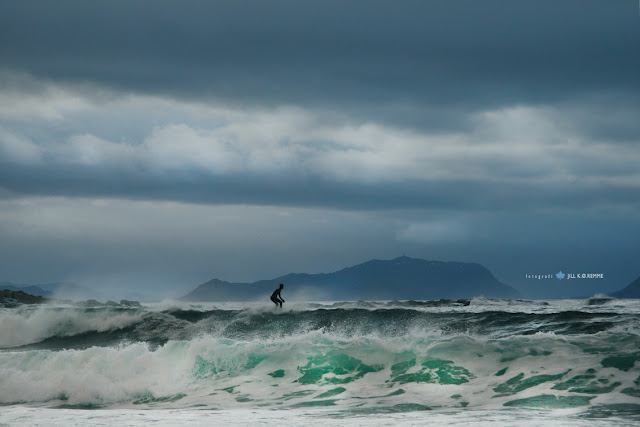
5) Have you exhibited your work apart from your blog? Do you sell your images?
I have a photo bank called www.moments.no but it is not in use. Have been planning to add my photos there. Where I stored them before was not to sell them but only for safekeeping.
If occasionally somebody wants to purchase pictures of course I say yes. I have no need to display my photos publicly, but if anyone likes them, I'm incredibly happy.
It's always great that someone appreciates what you do, but mostly I do it because I like it so much. It is a fantastic relaxation in my life. Just being in the moment and 100% alive it is something that we should do much more often. If there is too much stress in your life it makes you forget why we are here; Nature is there for a reason :))
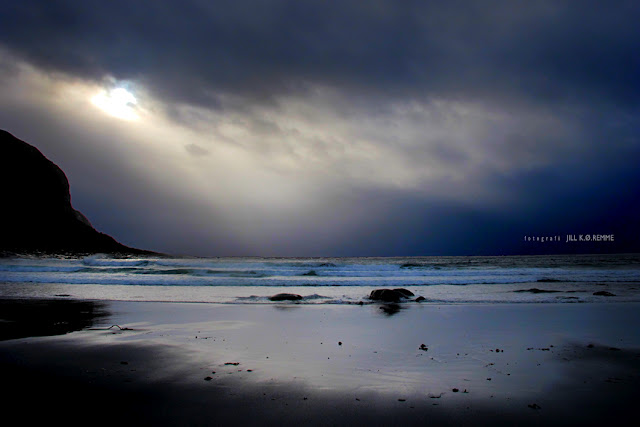
6) Lastly: do you travel around the world or do you concentrate to your local environment opportunities?
I traveled a lot before but after that we got our Samoyed Nansen (big white dog), we have not traveled that much the last 2 years. Now, Nansen is an adult and it is easier to get someone to watch him. So we look forward to being able to travel again more in the future. I love to explore the nature around me. The light out here by the sea change so often that it feels like I see the place for the first time, every time, if you know what I mean.
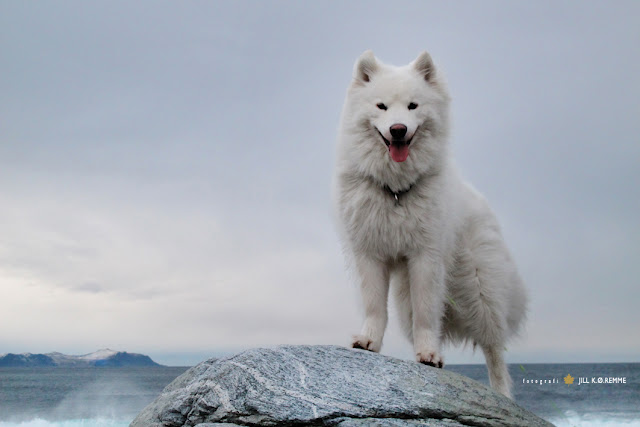
As a formal professional photographer with academic training I am humbled by Jill's skills and passion.
I appreciate her imagery for the candid representation of her life and environment, love for the outdoors and happiness of being outside. I wish one day to travel to Norway to experience the beauty of that incredible land and possibly meet Jill.
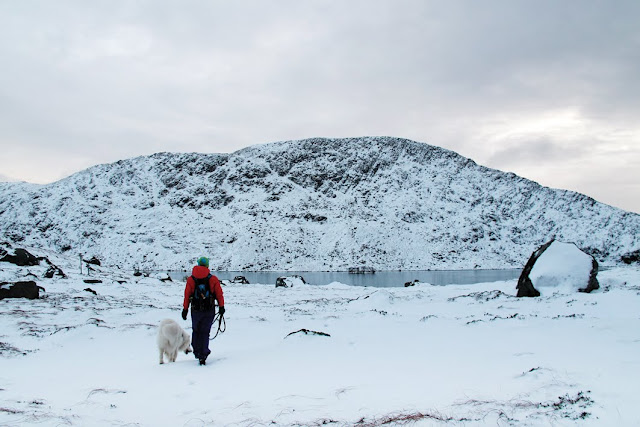
All images: Copyright Jill Remme 2012_used with permission
I stumbled across Jill's work when she became a follower of GnarlyDog News.
Her profile linked me to her blog site (jillremme.blogspot.com) and I was immediately taken by her images.

I have checked her blog on a regular basis for a while and every time I was really impressed with her work.
Jill possesses an incredible talent that allows her to view the world through the lens of a camera like very few other photographers can: to me, her images convey passion, happiness and love.
I finally approached Jill and asked her a few questions; I wanted to know how she developed that photographic view.
("amber" is GD, "light blue" is Jill)

1) Jill, you photographic work is outstanding. So, how long have you been photographing and what sparked the passion?
I guess all my beautiful tours in nature spark the passion further and further. The love for nature and the movement in a picture to capture the moment….I love coming home and see what is the catch of the day on my camera; it is one of my favorite thing to do. I had my first camera when I was 17, and I still have that old Canon. I think I spent a small fortune to capture images before digital came along.
2) Your work has a very friendly and lovable feeling. Your portraits depict very relaxed faces and the subjects are really pretty. Are they professional models or just friends?

It is mostly friends and family. I really enjoy taking pictures of my children. I have three daughters and one son, two of them are stepchildren :) It's always fun to be with them; so that's perhaps why they look so relaxed. And now I also have a grandchild; lucky me!
Occasionally people ask me if I can take their pictures, but I more often say no than yes :)
3) Do you spend some time planning the photographs that you are going to take or is it just candid capturing of moments as they happen in front of the camera? With the portraits, do you have any special technique to put your models at ease or are you just good friends and they feel relaxed?
I have no other technique than: I try to think of the light and movement: I try to catch people as they are in that moment, but it is not always so easy. I rarely or never plan. I get inspired by others and the pictures I see on the Internet and other places. What inspires me most is just being in nature and enjoying it. I also use Photoshop when images aren't captured they way I saw them.
I spend some time trying to think up new ideas and angles but I often feel that I repeat myself. Sometimes I succeed, sometimes not.

4) Your images are taken often in very cold places and you seem to love the outdoors a lot. Do you prepare or protect your digital cameras in any special way to make the battery last?

My camera is well tested in bad weather. I use my Canon D 30 mostly indoors and in dry weather, but my Canon G 12 stands up to the weather in the outdoors. There is a lots of rough weather where I live and I've already worn out a Canon G 12. When I bought a new I also bought a waterproof housing since I paddle a lot and I always have a camera ready with me.
I clean my camera almost always after a trip. When the weather is too wet, I use a plastic cover around the camera. If its really shitty weather, I have a bag that I use. If I am in extreme cold as -20C, I hang the camera away from me in the hallway so the lens does not fog up. The contrast from the outside and inside temperature is not good for the lens. I always have with me two camera batteries. The batteries run out quickly when exposed to such cold temperatures, but a little heat from my pocket revitalizes them again.

5) Have you exhibited your work apart from your blog? Do you sell your images?
I have a photo bank called www.moments.no but it is not in use. Have been planning to add my photos there. Where I stored them before was not to sell them but only for safekeeping.
If occasionally somebody wants to purchase pictures of course I say yes. I have no need to display my photos publicly, but if anyone likes them, I'm incredibly happy.
It's always great that someone appreciates what you do, but mostly I do it because I like it so much. It is a fantastic relaxation in my life. Just being in the moment and 100% alive it is something that we should do much more often. If there is too much stress in your life it makes you forget why we are here; Nature is there for a reason :))

6) Lastly: do you travel around the world or do you concentrate to your local environment opportunities?
I traveled a lot before but after that we got our Samoyed Nansen (big white dog), we have not traveled that much the last 2 years. Now, Nansen is an adult and it is easier to get someone to watch him. So we look forward to being able to travel again more in the future. I love to explore the nature around me. The light out here by the sea change so often that it feels like I see the place for the first time, every time, if you know what I mean.

As a formal professional photographer with academic training I am humbled by Jill's skills and passion.
I appreciate her imagery for the candid representation of her life and environment, love for the outdoors and happiness of being outside. I wish one day to travel to Norway to experience the beauty of that incredible land and possibly meet Jill.

All images: Copyright Jill Remme 2012_used with permission
tags
blog,
camera,
photography,
publishing,
readers,
review,
skills,
weather
06 March 2012
Kayaker's Ear - L'orecchio del Kayaker
A first for Gnarlydog News, here is a bilingual guest post from Marco Ferrario, a Gnarlydog News reader.
The English text is in YELLOW, the Italian text (original) is in GREEN.
Questa e` la prima pubblicazione di Gnarlydog News bilingue, cortesia di Marco Ferrario.
Il testo in VERDE e` in Italiano
KAYAKER’S EAR – L’ORECCHIO DEL KAYAKER
Rolling and tinnitus - Eskimo ed acufene
Il kayaker appassionato di rolling (eskimo) è un soggetto a rischio di acufene (tinnitus)?
Forse molti kayakers si chiederanno cosa centrano gli acufeni con il kayak da mare, ebbene ...
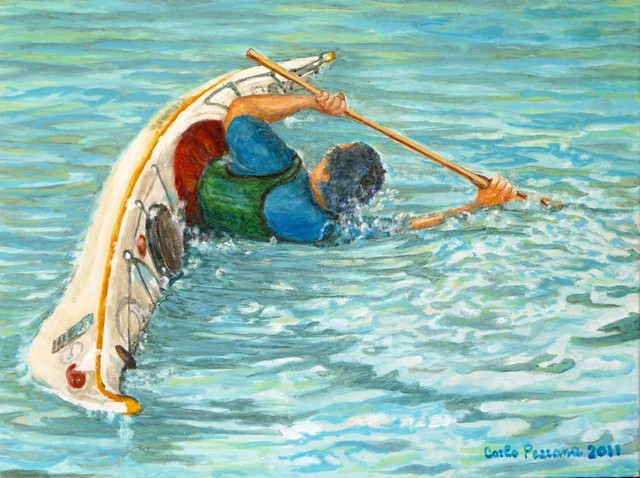
Image of KayArt - di Carlo Pezzana (http:/www.kayart.it)
Nel 1996 feci il mio primo corso di eskimo (rolling) in piscina.
Dopo le prime lezioni iniziai ad eseguire stentatamente i primi miei eskimo senza l’aiuto dell’istruttore.
Con soddisfazione avevo compiuto i primi passi verso questa divertente tecnica di auto-salvataggio.
Negli anni seguenti, provai più volte ad eseguire l’eschimo in mare, ma non sempre con successo , la mia esecuzione era ancora scadente.
Così, nell’inverno 2001-2002, per migliorarmi, tornai in piscina, che era a disposizione dei kayakers per una sera a settimana, per un paio d’ore.
Il divertimento e la soddisfazione nell'eseguire la manovra dell'eskimo, mi spingeva a provare e riprovare molte volte, continuativamente.
Per eseguire l’eskimo (rolling), dalla posizione seduta in kayak, si entra in acqua su un fianco, eseguendo un “piccolo tuffo” laterale, impattando contro la superficie dell’acqua.
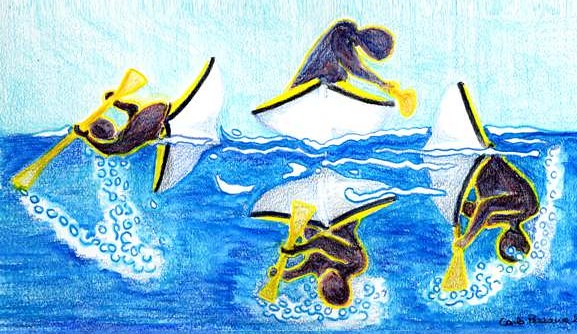
Il mio corpo entrava ed usciva dall'acqua e, una volta sott’acqua, rimanevo per alcuni secondi a testa
capovolta, prima di completare l’eskimo. Il fastidio dell’acqua nelle orecchie e nel naso era sopportabile, perciò non utilizzavo tappi per le orecchie e alcune volte non mettevo neanche la molletta per chiudere il naso. All’uscita dalla piscina, con la testa forse ancora un poco umida, percepivo tutto il gelo della serata invernale con temperature inferiori agli 0° centigradi e spesso avevo la sensazione di avere le orecchie chiuse e piene d'acqua. A volte l’udito, per i primi minuti, era ovattato e rimbombante, poi le orecchie si stappavano e il problema si risolveva, perciò non ho mai dato molta importanza a questo disturbo passeggero.
Una sera, tornato a casa, non riuscii più a liberarmi della sensazione di acqua nelle orecchie.
was finally releasing the water. But the feeling of getting rid of it was soon replaced by a constant
small noise, sensing that initially the noise came from the environment, instead I soon realized
it came from my ears. I had the impression that an insect has entered into my ear canal and, flapping frantically its wings, could not get out.
Since then, the high-pitched tinnitus hast never left me, I always hear it, constantly, and over time has increased in the intensity of perceived noise.
I feel it in my ears but it seems that it also extends into the upper part of the brain.
Mi sottoposi ad una sequenza di visite in centri specialistici otorinolaringoiatrici e audiologici, i medici mi prescrissero diversi esami, che feci regolarmente, ma che non mi permisero di capire come intervenire per risolvere il mio disturbo. Gli esami esclusero determinate patologie.
Sono trascorsi ormai molti anni, il suono dell'acufene è aumentato rispetto al periodo iniziale e si è anche
differenziato arricchendosi di nuove tonalità, sempre molto acute.
A volte assomiglia ad uno scroscio d'acqua, come fosse un rubinetto aperto, altre volte è un suono a metà strada tra una sirena e un fischio e l’impressione è che il timpano stia vibrando in continuazione.
L'udito ne risente sempre più (ipoacusia), come anche lo stress conseguente.
In questi anni mi sono informato e ho avuto modo di constatare che tra i soggetti più frequentemente a rischio d’acufene, c'è chi pratica sport acquatici o li ha praticati in passato, perciò i surfisti, i nuotatori, i tuffatori, chi pratica bodybording, kitesurf e chi, facendo immersioni, ha accusato problemi di compensazione.
Kayakers fluviali, hanno iniziato a soffrire di acufeni dopo un bagno in acque fredde, anche se indossavano il casco, che attutisce l'impatto con l'acqua.
A chi gli acufeni sono passati, ho l'impressione che sia stata più una casualità, piuttosto che una specifica cura. La maggioranza di chi ne soffre, ha imparato, necessariamente, a convivere con questi rumori persistenti.
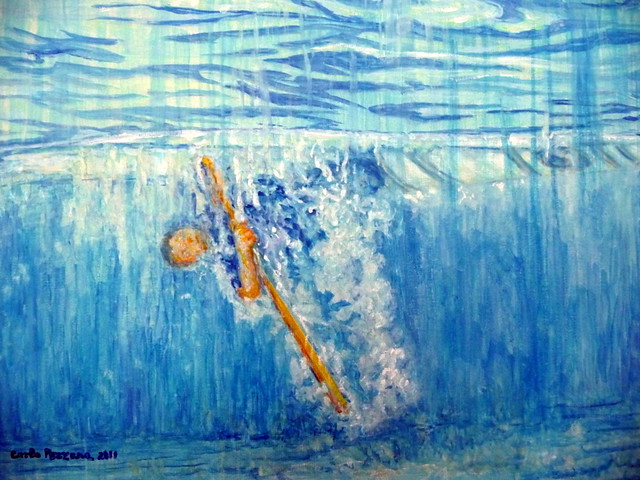
Imagee of KayArt - di Carlo Pezzana (http://www.kayart.it)
The English text is in YELLOW, the Italian text (original) is in GREEN.
Questa e` la prima pubblicazione di Gnarlydog News bilingue, cortesia di Marco Ferrario.
Il testo in VERDE e` in Italiano
KAYAKER’S EAR – L’ORECCHIO DEL KAYAKER
Rolling and tinnitus - Eskimo ed acufene
Il kayaker appassionato di rolling (eskimo) è un soggetto a rischio di acufene (tinnitus)?
Forse molti kayakers si chiederanno cosa centrano gli acufeni con il kayak da mare, ebbene ...

Image of KayArt - di Carlo Pezzana (http:/www.kayart.it)
Nel 1996 feci il mio primo corso di eskimo (rolling) in piscina.
Dopo le prime lezioni iniziai ad eseguire stentatamente i primi miei eskimo senza l’aiuto dell’istruttore.
Con soddisfazione avevo compiuto i primi passi verso questa divertente tecnica di auto-salvataggio.
Negli anni seguenti, provai più volte ad eseguire l’eschimo in mare, ma non sempre con successo , la mia esecuzione era ancora scadente.
Così, nell’inverno 2001-2002, per migliorarmi, tornai in piscina, che era a disposizione dei kayakers per una sera a settimana, per un paio d’ore.
Il divertimento e la soddisfazione nell'eseguire la manovra dell'eskimo, mi spingeva a provare e riprovare molte volte, continuativamente.
Per eseguire l’eskimo (rolling), dalla posizione seduta in kayak, si entra in acqua su un fianco, eseguendo un “piccolo tuffo” laterale, impattando contro la superficie dell’acqua.

Image of KayArt - di Carlo Pezzana (http://www.kayart.it)
The kayaker keen on rolling (Eskimo) is a subject at risk of tinnitus?
Perhaps many will wonder what kayakers and tinnitus have in common with sea kayaking; well ...
In 1996 I took my first kayak rolling course in the pool.
After the first lessons I started to run my first haltingly roll without the help of the instructor.
With satisfaction I had taken the first steps towards this fun technique of self-rescue.
In the following years, I tried several times to roll at sea but not always successfully, my
The kayaker keen on rolling (Eskimo) is a subject at risk of tinnitus?
Perhaps many will wonder what kayakers and tinnitus have in common with sea kayaking; well ...
In 1996 I took my first kayak rolling course in the pool.
After the first lessons I started to run my first haltingly roll without the help of the instructor.
With satisfaction I had taken the first steps towards this fun technique of self-rescue.
In the following years, I tried several times to roll at sea but not always successfully, my
performance was still poor.
Thus, in the winter of 2001-2002, to improve myself, I returned to the pool, which was available to kayakers one night a week, for a couple of hours. The fun and satisfaction in performing a roll pushed me to try again and again many times, continuously. To perform a roll, while sitting in a kayak, you enter the water on one side, performing a "little side dive", impacting against the surface of the water.
Thus, in the winter of 2001-2002, to improve myself, I returned to the pool, which was available to kayakers one night a week, for a couple of hours. The fun and satisfaction in performing a roll pushed me to try again and again many times, continuously. To perform a roll, while sitting in a kayak, you enter the water on one side, performing a "little side dive", impacting against the surface of the water.
Il mio corpo entrava ed usciva dall'acqua e, una volta sott’acqua, rimanevo per alcuni secondi a testa
capovolta, prima di completare l’eskimo. Il fastidio dell’acqua nelle orecchie e nel naso era sopportabile, perciò non utilizzavo tappi per le orecchie e alcune volte non mettevo neanche la molletta per chiudere il naso. All’uscita dalla piscina, con la testa forse ancora un poco umida, percepivo tutto il gelo della serata invernale con temperature inferiori agli 0° centigradi e spesso avevo la sensazione di avere le orecchie chiuse e piene d'acqua. A volte l’udito, per i primi minuti, era ovattato e rimbombante, poi le orecchie si stappavano e il problema si risolveva, perciò non ho mai dato molta importanza a questo disturbo passeggero.
Una sera, tornato a casa, non riuscii più a liberarmi della sensazione di acqua nelle orecchie.
Scuotevo la testa e mi schiaffeggiavo le tempie, ma nulla, le orecchie rimanevano tappate e persisteva la sensazione di avere ancora acqua nel loro interno.
In questa condizione rimasi per alcuni giorni, passati i quali, iniziai a percepire un miglioramento, l'orecchio si stava finalmente liberando dall'acqua, ma, alla sensazione di essersi liberati, si sostitui presto un costante piccolo fruscio. Inizialmente la sensazione fu che il fruscio provenisse dall’ambiente, ma presto mi resi conto che proveniva dalle mie orecchie.
Avevo l’impressione che un insetto sia entrato nel mio condotto uditivo e, sbattendo disperatamente le ali, non riusciva più ad uscire.
Da allora, l'alta tonalità dell'acufene non mi ha più lasciato, lo sento sempre, costantemente e, nel tempo,
è aumentata l'intensità del rumore percepito.
Lo sento nelle orecchie ma sembra che si estenda anche nella parte alta del cervello.
My body would enter and exit from the water, and once under water, woudl remaini for a few seconds head
upside down, before completing the roll. The discomfort of the water in the ears and nose was bearable, so I did not use ear plugs and sometimes would not even put on the clip to close the nose.
Walking away from the pool, my head maybe a little wet, I felt every chill of winter evening with temperatures below 0 ° Celsius often feeling my ears closed and full of water. Sometimes the hearing, for the first few minutes, was muffled, rumbling, then the ears uncorked, and the problem was solved; so I never gave much importance to this passing discomfort. One evening, returning home, I could no longer get rid of the feeling of water in the ears. I shook my head and tapped the sides, but nothing: the ears remained plugged and the persisting feeling of having more water in them.
I remained for several days in this condition, after which I began to feel an improvement: the earwas finally releasing the water. But the feeling of getting rid of it was soon replaced by a constant
small noise, sensing that initially the noise came from the environment, instead I soon realized
it came from my ears. I had the impression that an insect has entered into my ear canal and, flapping frantically its wings, could not get out.
Since then, the high-pitched tinnitus hast never left me, I always hear it, constantly, and over time has increased in the intensity of perceived noise.
I feel it in my ears but it seems that it also extends into the upper part of the brain.
Mi sottoposi ad una sequenza di visite in centri specialistici otorinolaringoiatrici e audiologici, i medici mi prescrissero diversi esami, che feci regolarmente, ma che non mi permisero di capire come intervenire per risolvere il mio disturbo. Gli esami esclusero determinate patologie.
Più specialisti contattavo e più mi convincevo che nessuno poteva offrirmi una soluzione certa.
La risonanza magnetica e la Tac esclusero problematiche ancora più serie.
Feci anche qualche tentativo di cura, ma senza successo, perciò mi rassegnai, sforzandomi di convivere con questo fastidioso rumore.
Image of KayArt - di Carlo Pezzana (http://www.kayart.it)Sono trascorsi ormai molti anni, il suono dell'acufene è aumentato rispetto al periodo iniziale e si è anche
differenziato arricchendosi di nuove tonalità, sempre molto acute.
A volte assomiglia ad uno scroscio d'acqua, come fosse un rubinetto aperto, altre volte è un suono a metà strada tra una sirena e un fischio e l’impressione è che il timpano stia vibrando in continuazione.
L'udito ne risente sempre più (ipoacusia), come anche lo stress conseguente.
In questi anni mi sono informato e ho avuto modo di constatare che tra i soggetti più frequentemente a rischio d’acufene, c'è chi pratica sport acquatici o li ha praticati in passato, perciò i surfisti, i nuotatori, i tuffatori, chi pratica bodybording, kitesurf e chi, facendo immersioni, ha accusato problemi di compensazione.
Kayakers fluviali, hanno iniziato a soffrire di acufeni dopo un bagno in acque fredde, anche se indossavano il casco, che attutisce l'impatto con l'acqua.
A chi gli acufeni sono passati, ho l'impressione che sia stata più una casualità, piuttosto che una specifica cura. La maggioranza di chi ne soffre, ha imparato, necessariamente, a convivere con questi rumori persistenti.

Imagee of KayArt - di Carlo Pezzana (http://www.kayart.it)
I started a sequence of visits to specialist centers and ENT doctors prescribed me different
exams, which I did regularly, but that did not allow me to understand how to intervene to solve my trouble. exams
ruled out certain diseases.
The more specialist I contacted the more I was convinced that no one could offer a reliable solution.
MRI and CAT scan ruled out more serious problems.
I also made some attempts to cure, but without success, so I resigned myself, trying to live with
this annoying noise.
exams, which I did regularly, but that did not allow me to understand how to intervene to solve my trouble. exams
ruled out certain diseases.
The more specialist I contacted the more I was convinced that no one could offer a reliable solution.
MRI and CAT scan ruled out more serious problems.
I also made some attempts to cure, but without success, so I resigned myself, trying to live with
this annoying noise.
It has been many years; the sound of tinnitus has increased compared to the initial period and it is also
differentiated enriched with new shades, always very acute.
At times resembling a roar of water, like a tap running, other times it sounds somewhere between a siren and a whistle, and the impression is like that the eardrum is vibrating constantly.
My hearing is affected (hearing loss), as well as the resulting stress.
All these years that I have gathered information and my observations have lead that among those most frequently at risk of tinnitus are those who practice water sports or practiced them in the past. So surfers, swimmers, divers, bodyboarders and kitesurfers, scuba diviners, lament Compensation Issues.
River kayakers began to suffer from tinnitus after a dunk in cold water, even if they wore a helmet, which dampens the impact with the water.
differentiated enriched with new shades, always very acute.
At times resembling a roar of water, like a tap running, other times it sounds somewhere between a siren and a whistle, and the impression is like that the eardrum is vibrating constantly.
My hearing is affected (hearing loss), as well as the resulting stress.
All these years that I have gathered information and my observations have lead that among those most frequently at risk of tinnitus are those who practice water sports or practiced them in the past. So surfers, swimmers, divers, bodyboarders and kitesurfers, scuba diviners, lament Compensation Issues.
River kayakers began to suffer from tinnitus after a dunk in cold water, even if they wore a helmet, which dampens the impact with the water.
In those cases where the tinnitus is gone, I feel that it's been more of chance, rather than a specific care.
The majority of sufferers have learned, by necessity, to live with these persistent noises.
The majority of sufferers have learned, by necessity, to live with these persistent noises.
C'è poi chi afferma di aver eliminato l'acufene dopo una terapia intensiva, durata diversi mesi, con un potente antiossidante ad azione neurotrofica. Altri dicono che si può provare con l'agopuntura. Alcuni hanno provato ad utilizzare, come palliativo, apparecchi acustici che rilasciano un suono mascheratore, che dovrebbe essere l'eguale-contrario al suono dell'acufene percepito e pertanto dovrebbe annullarne il rumore originario, ma tra chi ha adottato questi apparecchi, non conosco nessuno che ha veramente risolto definitivamente il problema. Un medico mi ha detto che in America è possibile intervenire chirurgicamente, ma l’intervento è molto costoso e rischioso, in quanto può provocare facilmente la perdita totale dell'udito. Una volta verificato che l'acufene non è un problema di cerume nell'orecchio e dopo e dopo aver fatto gli esami che escludono le cause extraotogene (cioè malattie che non dipendono dall'orecchio), i medici pensano che la causa del mio acufene sia dovuta a una deformazione o inspessimento o spostamento di un ossicino dell’orecchio, problema causato molto probabilmente da una esposizione all'acqua e, contemporaneamente, al freddo. Sta di fatto che nessun medico è in grado di garantirmi la guarigione, al punto che sono ormai dell'idea che non mi libererò mai più dall'acufene e credo che presto sarò costretto a cercare una soluzione per migliorare il mio udito, che nel tempo si è decisamente ridotto.
There are some who claim to have eliminated the tinnitus after an intensive period of several months, with a powerful neurotrophic with antioxidant action.
Others say to try acupuncture. Some have tried to use, as palliative care, hearing aids that emit a masking sound, which would be exact contrary to the perceived tinnitus sound, and therefore should cancel the original noise. Between those who adopted these devices, I do not know of anyone who has really solved definitely the problem. A doctor told me that in America you can perform surgery, but surgery is very expensive and risky as it can easily lead to total hearing loss.
Once I have verified that tinnitus was not a problem of earwax in the ear and after carring out many tests that would excluded external factors (ie diseases that do not depend on the ear), the doctors think that the cause of my tinnitus is due to a thickening, deformation or displacement of an ear bone, a problem most likely caused by the exposure to water and at the same time to cold.
The fact is that no doctor is able to guarantee me the healing, to the point that they are now of the idea that I will never rid myself from tinnitus and I think that soon I will be forced to seek a solution to improve my hearing, that over time has significantly reduced.
Others say to try acupuncture. Some have tried to use, as palliative care, hearing aids that emit a masking sound, which would be exact contrary to the perceived tinnitus sound, and therefore should cancel the original noise. Between those who adopted these devices, I do not know of anyone who has really solved definitely the problem. A doctor told me that in America you can perform surgery, but surgery is very expensive and risky as it can easily lead to total hearing loss.
Once I have verified that tinnitus was not a problem of earwax in the ear and after carring out many tests that would excluded external factors (ie diseases that do not depend on the ear), the doctors think that the cause of my tinnitus is due to a thickening, deformation or displacement of an ear bone, a problem most likely caused by the exposure to water and at the same time to cold.
The fact is that no doctor is able to guarantee me the healing, to the point that they are now of the idea that I will never rid myself from tinnitus and I think that soon I will be forced to seek a solution to improve my hearing, that over time has significantly reduced.
Che dire ancora?
Ecco qualche suggerimento, dettato dalla mia esperienza, nella speranza possa essere utile a prevenire
l'acufene negli appassionati di kayak e di eskimo (rolling).
Certezze non ne ho e non ho una cultura medica, ma, da kayaker, consiglierei di non eseguire l'eskimo senza dei buoni tappi nelle orecchie e una molletta stringi naso, per ottenere un sigillo totale. Orecchio e naso sono collegati e perciò l'acqua che entra dal naso raggiunge il timpano e l'orecchio medio, credo sia opportuno tappare entrambi.
Queste precauzioni sono tanto più importanti, quanto l’acqua e/o la temperatura esterna è fredda.
Le orecchie vanno protette anche in caso di forte vento e in particolare in caso di vento gelido.
Conoscere e confrontare le esperienze potrebbe essere molto utile.
E’ necessario sapere quali sono i rischi per le orecchie del kayaker, per prevenire l’acufene; e conoscere i rimedi efficaci, se esistono, per chi ne è affetto.
N.B. - quando pagaio, come quando sono molto concentrato a svolgere con passione qualche lavoro, pur essendo l'acufene sempre presente, non ci penso e lo percepisco meno, mentre ora che ne sto parlando, anzi scrivendo, raccontandolo, il tinnitus è fortissimo.
Un saluto con pagaia.
Marco
(Eko) http://ekokayak.wordpress.com
ekokayak@gmail.com
ekokayak@gmail.com
What else can I say?
Here are some suggestions, derived from my experience in hope they will be useful to prevent
tinnitus in kayakers and rollers.
I don't have certainties or medical knowledge, however, as kayaker, I recommend not to roll without some good earplugs and a tight nose clip , to obtain a total seal. Ear and nose are connected and therefore the water that comes from the nose reaches the eardrum and middle ear, I believe both.must be stopped.
These precautions are even more important when water and /or the outisde temperature is cold.
The ears should be protected even in windy conditions, especially in freezing wind. To know and compare the experiences could be very useful. And 'need to know what are the risks to the ears of the kayaker to prevent tinnitus; and know the effective remedies, if any, for those affected.
NB - When I paddle, as when I am very passionately focused with a job, while the tinnitus being always present, and I do not think about it and I feel it less, but now that I'm talking about, even writing, describing it, tinnitus is very strong.

photo by Marco Ferrario, publisher of Ekokayak on a trip in Sardegna
This article was translated with Google Translate with additional corrections.
Here are some suggestions, derived from my experience in hope they will be useful to prevent
tinnitus in kayakers and rollers.
I don't have certainties or medical knowledge, however, as kayaker, I recommend not to roll without some good earplugs and a tight nose clip , to obtain a total seal. Ear and nose are connected and therefore the water that comes from the nose reaches the eardrum and middle ear, I believe both.must be stopped.
These precautions are even more important when water and /or the outisde temperature is cold.
The ears should be protected even in windy conditions, especially in freezing wind. To know and compare the experiences could be very useful. And 'need to know what are the risks to the ears of the kayaker to prevent tinnitus; and know the effective remedies, if any, for those affected.
NB - When I paddle, as when I am very passionately focused with a job, while the tinnitus being always present, and I do not think about it and I feel it less, but now that I'm talking about, even writing, describing it, tinnitus is very strong.

photo by Marco Ferrario, publisher of Ekokayak on a trip in Sardegna
This article was translated with Google Translate with additional corrections.
Subscribe to:
Posts (Atom)



